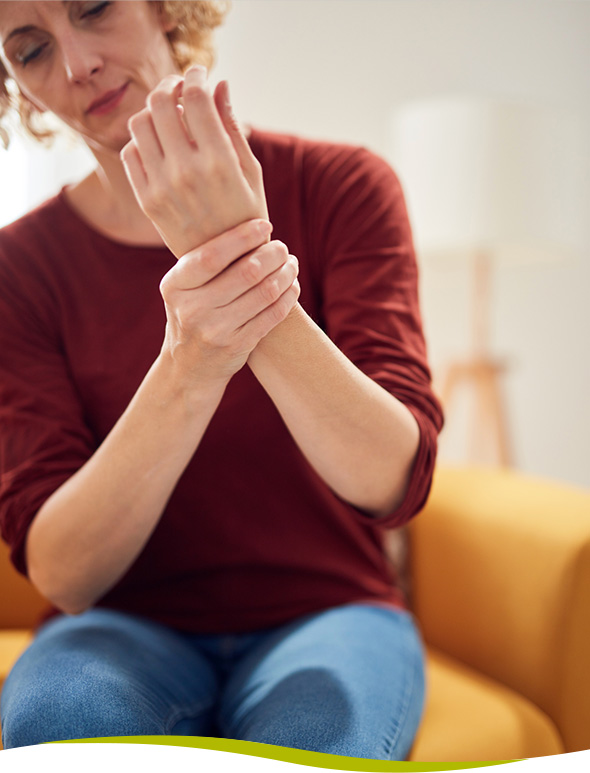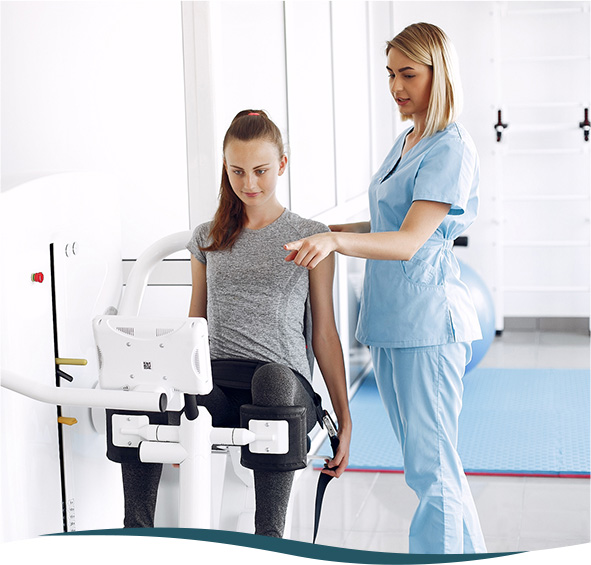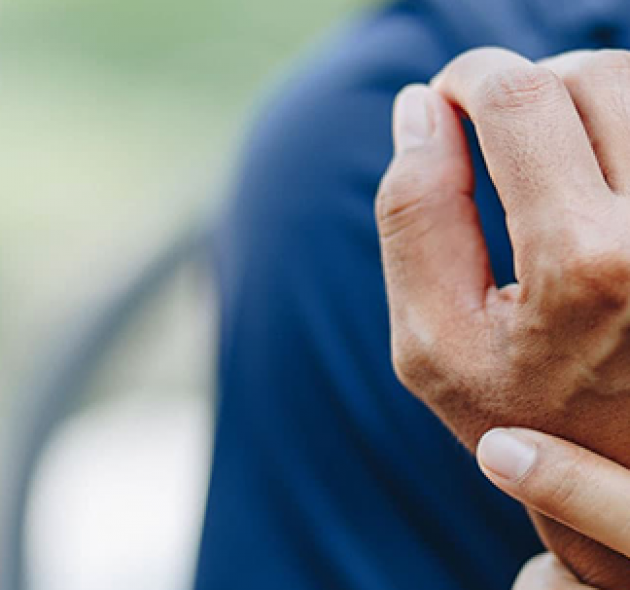Lorem ipsum dolor sit amet, consectetur adipiscing elit. Sed molestie tristique facilisis. Integer pretium nec diam a faucibus. Vivamus lacinia et nulla
What Is Osteoarthritis?
Arthritis is one of the most common joint diseases worldwide…
What is arthritis?
Arthritis is one of the most common joint diseases worldwide. It owes its name to the Greek “arthros”, which means joint. Specifically, arthritis is a disease of the joint cartilage in which the natural balance between cartilage formation and cartilage degradation is disturbed.
This results in progressive cartilage wear, which is often associated with very severe pain for those affected. The more damaged the affected cartilage, the more severe the symptoms and the greater the deformation of the joint even leading to complete loss of functioning.
However, arthritis is not simply an age-related wear-and-tear condition. The disease is primarily caused by long-lasting inflammatory processes that are often not noticeable at first. These lead to the cartilage receiving too few nutrients which it needs to be able to fulfil its main functions. Therefore, vitamins, trace elements and other substances play an important role in cartilage health: they can help to increase the cartilage mass, counteract its degradation and even regenerate it.
Wear of the joints often begins around the age of 45, initially without symptoms. However, the symptoms become more frequent between the ages of 50 and 60: among the over 60s, one in two women and one in three men have to struggle with this disease, and from the age of 65 onwards almost everyone, male or female, suffers from arthritis.

Symptoms
When the joints wear out, the first symptom is discomfort on exertion. As the disease progresses these symptoms become more frequent, even during everyday activities. Morning stiffness and so-called start-up pain are typical of arthritis. These pains occur with the first movements after rest. After taking a few steps the pain subsides.
Night-time pain and related sleep disturbances occur as the disease progresses, with painful and painless phases alternating over a long period of time. Gradually, an excruciating continuous pain develops. The symptoms often worsen in cold and damp weather conditions and during physical exertion.
Causes
Severe stress due to hard work, excessive sport, high body weight, environmental factors, heredity, but also metabolic disorders such as gout or diabetes: all these factors may contribute to the development of arthritis and play a role in its development or its severity. Joint injuries can be a cause too, because even the smallest injuries can damage the cartilage and lead to the disease, which is common in about one third of all cases. Above all, however, the development of arthritis is triggered by acute or chronic inflammations of the joint. Depending on the cause, a distinction is made between two forms: primary arthritis and secondary arthritis.
Primary arthritis
This form of arthritis is mainly due to genetic causes or hereditary predisposition and often starts from the age of 45. Even years of light sport or housework can cause this type of arthritis, which does not occur in people without genetic predisposition when they carry out similar activities.
Secondary arthritis
Contrary to to primary arthritis, in secondary arthritis it is possible to identify certain factors that adversely affect or cause joint wear, for example lifestyle, overweight, unfavourable posture, congenital deformities such as knock knees, bow legs or hip dysplasia, heavy physical work or constant stress. All these factors can be responsible for the development of this form of arthritis. Certain sports such as excessive jogging and some extreme sports can also lead to joint inflammation and ultimately to cartilage breakdown. Although secondary arthritis can affect anyone, it also gives those affected the opportunity to take protective measures against the disease, for example by reducing their body weight and adopting a healthier lifestyle.

Types of Arthritis
Although arthritis can occur in any joint of the body, it’s most likely to affect the knee, the hip and the shoulder. Other joints such as the spine, finger, toes and ankles can be affected by arthritis, too.
Knee arthritis
Knee arthritis (the medical term is gonarthritis) is the most common form of arthritis and mainly affects older people close to retirement age. In early stages of the disease, the people affected may feel non-specific pain, for example when standing up, or have a feeling of warmth or slight swelling in the affected joint, all symptoms that indicate inflammation of the joint. As the illness progresses, it can manifest itself with start-up pain, increased stiffness, loss of stability and increased sensitivity to damp and cold weather.
In addition, the leg becomes weaker and a knee joint effusion can appear. Other symptoms include crunching and cracking sounds when the knee moves, pain when climbing stairs and walking on uneven ground, pain behind the kneecap after sitting for long periods of time, discomfort when carrying heavy objects. The pain becomes more severe and frequent as the disease gets worse, and the knee gradually loses mobility. At this point, the cartilage is often more or less destroyed.
Hip arthritis
Hip arthritis, also called coxarthritis, is mostly due to secondary arthritis and also generally appears at retirement age. Excessive weight is considered to be the main risk factor, other triggers are unfavourable posture, inappropriate load distribution and overstraining due to sport and heavy physical work.
At the beginning of the disease, there are often uncharacteristic signs of fatigue, such as a feeling of heaviness in the legs after exertion, and radiating pain is not uncommon. Another typical symptom is limping, in which the affected person stands for a shorter period of time on the damaged leg during movement. About one third of those affected also suffer from severe knee pain. A difference in the length of the leg can also often be seen, caused by the shortening of the muscles around the joint.
Arthritis of the metacarpus and the wrist
Radiocarpal arthritis, i.e. arthritis of the carpometacarpal joint and the wrist joint, is extremely common and usually a form of secondary arthritis caused by stress. In women, wrist arthritis accounts for almost half of all joint diseases. Other causes include bone fractures that destroy the joint surface or tears in the ligaments between the carpal bones which compromise the harmonious movement of the bones.
Rheumatism is also known as a cause. In radiocarpal arthritis, patients initially suffer from painless movement restrictions, but pain of varying intensity develops in the later stages. Sensitivity to the weather, especially cold wet weather, and swelling are common symptoms, too. As with all secondary forms, in radiocarpal arthritis the joint inflammation can last for a long time before the actual cartilage damage occurs.
Finger arthritis
This is one of the most common diseases of the finger joints. Women suffer from it more often than men, especially after the menopause. Finger arthritis usually affects both hands or middle joints, and can also lead to the formation of nodules. This form of arthritis often appears in a combination with arthritis of the thumb basal joint. Finger arthritis often manifests itself in a marked sensitivity of the fingers to cold; in addition, the cosmetically disturbing aspect caused by the formation of lumps lies in the foreground.
Shoulder arthritis
The cartilage surface of the shoulder joint can also wear down, but shoulder arthritis, or omarthritis, rarely occurs because the shoulder, unlike hips and knees, has to bear a lighter load. The symptoms begin insidiously: the first warning sign is rapid fatigue during overhead work. In the advanced stages, swelling, constant pain and pain at rest are typical. The feeling of stiffness of the joint and limitations in general mobility indicate severe arthritis of the shoulder joint. Omarthritis is usually caused by severe injuries to the ligamentous apparatus that is supposed to protect the shoulder joint or even a fracture of the humeral head.
Arthritis of the spine
Arthritis of the spine, also called facet syndrome, occurs mainly in older people. Sport induced injuries, heavy work and overweight are well-known triggers of the disease. Recurring intervertebral disc problems are considered a risk factor, too. Typical of this form of arthritis is severe pain in the lumbar region, which often cannot be assigned locally. The pain usually intensifies during the day and after physical exertion and improves when lying down. Back pain often radiates to the legs, the abdomen or the buttocks, as this form of arthritis is often accompanied by nerve irritation.
Progressive forms
Arthritis has many faces: it begins insidiously, usually with the slow development of mild inflammation and superficial cartilage damage that is hardly noticeable. In a later stage of the disease, however, the continuous deterioration of cartilage leads to joint instability and severe pain, caused by the strong inflammation and by the exposed bones rubbing against each other.

In latent arthritis, those affected have no complaints, inflammations cannot be detected and any changes to the cartilage can only be seen through X-rays. The symptoms of dormant arthritis are a little different: mobility is increasingly reduced, with feelings of tension in the joint as the inflammation slowly progresses and the joint capsule slowly stretches. Grinding and rubbing noises in the joint may also occur. The pain often only appears in response to changes in the weather.
In this phase, the joint is already severely inflamed, the joint space is stretched and the cartilage surfaces are damaged several times, which causes a number of complaints, such as swelling and overheating of the joint, with redness also possible. Even at rest, it is possible to feel intense joint pain because the joint capsule is severely stretched, which leads to persistent pain.
As the disease progresses, the range of motion reduces significantly. In this stage of the disease, the problem affects the entire joint apparatus. In addition, the joints become unstable. The cartilage damage is very advanced here, so that the bones are partially exposed, rubbing against each other and causing constant pain. This results in an increasing incorrect load distribution on the joint, which leads to an intensification of the arthritis.
In this phase, there are severe deformations of the affected joints. Bony nodules can appear at the former cartilage edges. These bony changes are extremely painful and make any movement of the affected areas almost impossible. If left untreated, this condition may also lead to the joint bones growing together, resulting in a complete loss of mobility.
Treatment options
The main aim of a cause-related osteoarthritis therapy is always to reduce inflammation, relieve pain, restore mobility and slow down the progression of the disease.
There is a wide range of treatment options, from conservative to surgical procedures, as well as alternative treatments. Not all of them have proven successful, and some also cause side effects. What the latest findings show: certain substances can make an important contribution to cartilage health and have a very positive effect on many arthritis complaints, without undesirable side effects.



